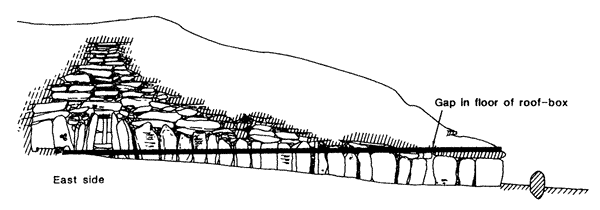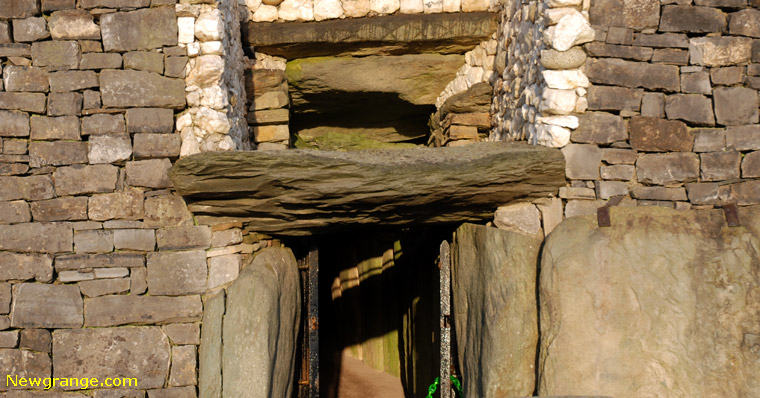The winter solstice phenomenon at Newgrange
The winter solstice phenomenon at Newgrange, Ireland: Accident or Design by T.P. Ray, School of Cosmic Physics, Dublin Institute for Advanced Studies, IrelandOn Midwinter's Day, around four and a half minutes after sunrise, the sun shines down the 'roof-box' of the Neolithic passage graves of Newgrange, Ireland, and illuminates the floor of its main chamber 18m away. When the monument was constructed, however, the first light would have occurred at sunrise in the form of a very narrow beam bisecting the chamber. Here I suggest that the width and height of the gap in the floor of the roof-box may have been deliberate, tracing the path of the sun at the solstice. Newgrange predates the astronomical structures of Stonehenge by 1,000 years and as such may be the oldest astronomically orientated structure in the world.
Located some 50km from Dublin, Newgrange is the largest in a group of Neolithic passage graves in the Boyne Valley, County Meath. Although discovered in 1699, the tomb was not properly excavated until the 1960s. It consists of a passage and chamber off which are three smaller alcoves, giving the structure an overall cruciform appearance. Surrounding it is a large circular mound, over 80m in diameter, of loose stones, and encircling this again is an incomplete ring of standing stones. The mound and ring are, however, not concentric and probably not contemporaneous.

Plan of Newgrange tomb, the marked line shows the minium azimuth or 'first-light' axis of the passage.
As early as 1909, Lockyer remarked that the passage grave was approximately aligned to the rising Sun at midwinter. He did not, however, pay much attention to the site. During recent excavations of Newgrange, O'Kelly unearthed a curious decorated structure located above the entrance to the tomb. This structure, which was later to be called the 'roof-box', covered a vertical gap between the first and second roof slabs of the passage.
Conscious of a local tradition that the chamber was illuminated by the Sun at a certain time of the year, O'Kelly investigated whether the roof-box had some solar function, and found that the midwinter Sun shone through the roof-box and gap to illuminate the central chamber of the tomb 18m away. This event would have occurred even if access to the tomb was blocked by the entrance stone.
Patrick later concluded that the orientation of the roof-box towards the winter solstice was deliberate. Heggie has pointed out, however, that on the basis of Patrick's calculations, the Sun would illuminate the main chamber if its declination lay at any position between -22°58' and -25°53', and hence the probability of a solsticial alignment in the corresponding range of azimuths is about 1 in 13. Heggie concluded that this fact was 'not really significant enough to excite much interest'.
But Heggie's calculation is in error for two reasons. First, as will be discussed below, Patrick's upper azimuth limit is about 1° too high and hence the declination range should be reduced accordingly. Second, and more importantly, the three-dimensional aspect of this problem has been ignored.
As can be seen the solsticial light from the roof-box meets the floor at a glancing angle within the main chamber. If the gap between the first two roof-slabs was, say, 20 cm lower, or equivalently the passage was a few metres longer, sunlight would not enter the chamber. In fact, one would then observe the Boyne Valley, rather than the local horizon, through the gap. Correspondingly, if the gap was higher, the solsticial light would have been projected onto the back wall. Although such an alignment is of course admissible for statistical purposes, it would not have as dramatic an effect as that of a glancing beam on the floor. Thus the chance of Newgrange being accidentally aligned with a solsticial sunrise/sunset point is smaller, at least by a factor of two, than the figure quoted by Heggie.
Nevertheless the evidence still remains weak and it would not rival that found for sites such as Stonehenge and Kintraw. To test the solar hypothesis further, we re-surveyed the roof-box, as seen from the main chamber, and the local horizon in the direction of sunrise on Midwinter's Day.
The passage itself is sinuous (Fig. 1), restricting the range of azimuths from which a ray of light can enter the main chamber. We found this range to be 133°49' - 137°29 at the chamber entrance, with a typical error of about +/-3'. The upper limit is ~1° greater than that quoted by Patrick. We measured the light beam to be just under 34 cm wide near the entrance although it narrows towards the back recess, largely because stone L20 leans inwards. Close to the entrance to the chamber, however, L20 restricts the width of the light beam by 8 cm at most, so that if L20 were uprighted the minimum azimuth would be less than the quoted value by only 20'.
The chamber floor is slightly lower than the gap in the roof-box and hence at low altitudes, the light of the Sun is spread across the floor. The minimum altitude at which sunlight can enter the chamber is given by the height of the local horizon, 55' +/-2', whereas the maximum altitude, confirmed by actual timing; measurements of when the Sun disappeared (F. Prendergast, private communication) from the main chamber, is 2°11' +/-2'. Using height measurements of the gap behind the roof-box and the chamber floor, we found that light at minimum elevation would reach at least 1 meter into the back recess.
However, sunlight is now seen to extend only as far as the edge of this alcove, because the minimum azimuth axis, or 'first light' axis, of the passage does not point towards midwinter sunrise. In fact, light from the right-hand limb of the Sun first enters the main chamber four and a half minutes after sunrise (F. Prendergast, personal communication), and at that time the Sun is almost completely above the horizon.
The question then arises as to what would have been the solar alignment when the monument was built. Carbon dating of two charcoal samples from between the roof-slabs yielded radiocarbon ages of 4,450 +/-40 and 4,460+/-45 BP. To convert this to a calendar date, we have used the dendrochronological record provided by samples of Irish Oak. This indicates that the probable construction period for the site is 3,150+/- 100 BC.
For these dates the obliquity of the ecliptic would have been 24°2' +/-1' and the midwinter Sun would rise at an azimuth of 133°54 +/-4'. Here we have assumed, for calculating refraction, a pressure of 1,010 mbar, a temperature of 0°C and the height of the local horizon to be 55° +/-2'. Variations in temperature and pressure make very little difference to the result. We see that the Sun would have risen just within the limits of the roof-box as seen from the main chamber. In other words, the 'first-light axis of the passage corresponds, within 5' or so, to midwinter sunrise 5,150 years ago.
If, at that time, one assumes that stone L20 was in an upright position, the accuracy would still be better than 25'. It follows that when Newgrange was built, the first beam of sunlight on the floor was less than 10 cm wide, approximately 2M long, and bisected the chamber. Rather curiously, this beam would have entered the back recess and indirectly illuminated a three-leafed spiral figure on its wall, as mentioned in legend.
As the Sun's altitude and azimuth increased, the beam would have become gradually broader. The height of the gap behind the roof-box varies between 18 and 22 cm, being 20 cm on average. As seen from the main chamber 18m away, this gap subtends an angle of roughly 38', so that the risen Sun is framed in the vertical direction. Finally, the lower edge of the Sun would have left the roof-box, as seen from the main chamber, at an azimuth of 137°42' +/-5'. Again this is very close to the maximum azimuth of the passage, implying a symmetry with respect to the Sun's passage at the winter solstice. Thus not only the height but also the width of the gap may be significant.
Newgrange predates the astronomically orientated structures (phase III) of Stonehenge by about 1,000 years. The evidence presented here supports the theory that the orientation of Newgrange was deliberate, which would make it therefore the oldest megalithic structure known for certain to have an astronomical function. The alignment at Newgrange was within a fraction (that is, within .5°) of the Sun's disk although it is doubtful whether the accuracy extends to the level of a few arcminutes. Newgrange should be seen in the light of large-scale studies such as those of Ruggles, which show definitive evidence that megalithic man was interested in marking the southern limits in declination of the Sun and Moon, albeit approximately. Such low accuracies suggest that ancient man's interest in these bodies may have been ritualistic rather than for the purpose of calendar construction.
We acknowledge the assistance of Muiris De Butleir, Senior Surveyor at the National Monuments Section, Office of Public Works and the support of the Office of Public Works, Dublin. Thanks are also due to Tim O'Brien for his help.
The winter solstice phenomenon at Newgrange, Ireland: Accident or Design by T.P. Ray.
Reprinted from Nature, Vol. 337, No. 6205, pp. 343-345, 26th January, 1989 © Macmillan Magazines Ltd., 1989.
Boyne Valley Private Day Tour
 Immerse yourself in the rich heritage and culture of the Boyne Valley with our full-day private tours.
Visit Newgrange World Heritage site, explore the Hill of Slane, where Saint Patrick famously lit the Paschal fire.
Discover the Hill of Tara, the ancient seat of power for the High Kings of Ireland.
Book Now
Immerse yourself in the rich heritage and culture of the Boyne Valley with our full-day private tours.
Visit Newgrange World Heritage site, explore the Hill of Slane, where Saint Patrick famously lit the Paschal fire.
Discover the Hill of Tara, the ancient seat of power for the High Kings of Ireland.
Book Now
Home
| Visitor Centre
| Tours
| Winter Solstice
| Solstice Lottery
| Images
| Local Area
| News
| Knowth
| Dowth
| Articles
| Art
| Books
| Directions
| Accommodation
| Contact





